The charts that matter – is it turnaround time for the dollar?
The US Federal Reserve’s slightly more aggressive than expected stance gave the dollar a fillip. John Stepek wonders if it’s time for a turnaround.

It's been another potentially significant week for most of our charts that matter'. Gold took a bit of a knock again this week as the US Federal Reserve's decision came out as being a little more hawkish than anyone had expected.
On the face of it, the Fed didn't do anything particularly surprising. The market had expected the Fed to announce balance sheet "normalisation" in October. But it was a tiny bit more punchy than that there's still a feeling among those on the Fed's rate-setting committee that it'll raise interest rates at least once more this year.
The market tends to lean towards expecting the Fed to surprise on the dovish side rather than the hawkish side, So that made for a stronger dollar.
Subscribe to MoneyWeek
Subscribe to MoneyWeek today and get your first six magazine issues absolutely FREE

Sign up to Money Morning
Don't miss the latest investment and personal finances news, market analysis, plus money-saving tips with our free twice-daily newsletter
Don't miss the latest investment and personal finances news, market analysis, plus money-saving tips with our free twice-daily newsletter
Gold
As a result, gold's fallen down through the $1,300 an ounce mark again.
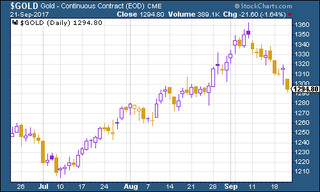
(Gold: three months)
US dollar
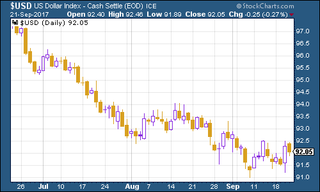
Meanwhile, the US dollar index has perked up significantly. Is this a turning point for the dollar? It's one of the most important prices in the world, but if it does start to rise significantly, then the already-expensive US stockmarket could be in trouble (S&P 500 companies make a lot of their earnings around the globe when the dollar goes up, their products become a little harder to sell and earnings fall under pressure).
This is vital to watch a blip higher is one thing (the dollar has fallen a lot) but if this is a genuine long-term shift higher, then it could make a big difference to markets across the world.
US Treasuries
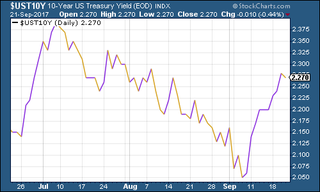
As investors started to re-evaluate the chances of rates rising again, ten-year US Treasury bond yields perked up a little.
Copper
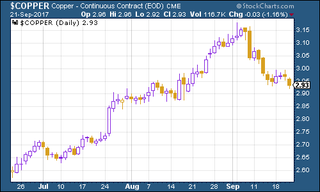
Copper is still on a breather. It's fallen harder than I expected and it's interesting to note that it hasn't taken a lot to get the market extremely bearish on it again. To me that's a good contrarian sign that the market psychology remains sceptical of the inflation story, which in turn means it's the one thing that we really should be watching out for.
Bitcoin
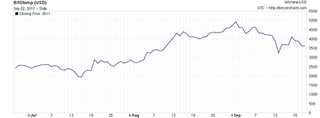
US jobless claims
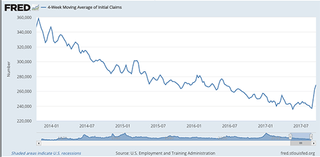
According to David Rosenberg of Gluskin Sheff, when US jobless claims hit a "cyclical trough" (as measured by the four-week moving average), a stock market peak is not far behind (on average 14 weeks), and a recession follows about a year later. If 20 May holds as the cyclical trough, then if Rosenberg is right (and to be fair, it's a small data set) we might already have seen the stockmarket peak, but I'd withhold judgement for now.
Oil price
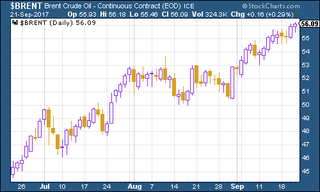
(Brent crude oil: three months)
Chart number seven is the oil price (as measured by Brent crude, the international/European benchmark). Oil has headed higher again this week, partly due to hurricane disruption and partly as a side effect of the falling dollar. What's interesting to me here is that oil has just steadily crept higher and it's fair to say that no one is paying a lot of attention to it.
My colleague Dominic wrote about this phenomenon in Money Morning earlier this week and I have to say that while I have no strong desire to invest in oil right now, the charts do seem to be going oil's way.
Amazon

(Amazon: three months)
Finally there's Amazon. As the wider US markets remain close to record highs, Amazon remained well off its August high. The political attitude towards the big tech stocks is starting to sour (as my colleague Merryn discusses in this week's MoneyWeek magazine) and this showed up in Amazon's share price this week.
John is the executive editor of MoneyWeek and writes our daily investment email, Money Morning. John graduated from Strathclyde University with a degree in psychology in 1996 and has always been fascinated by the gap between the way the market works in theory and the way it works in practice, and by how our deep-rooted instincts work against our best interests as investors.
He started out in journalism by writing articles about the specific business challenges facing family firms. In 2003, he took a job on the finance desk of Teletext, where he spent two years covering the markets and breaking financial news. John joined MoneyWeek in 2005.
His work has been published in Families in Business, Shares magazine, Spear's Magazine, The Sunday Times, and The Spectator among others. He has also appeared as an expert commentator on BBC Radio 4's Today programme, BBC Radio Scotland, Newsnight, Daily Politics and Bloomberg. His first book, on contrarian investing, The Sceptical Investor, was released in March 2019. You can follow John on Twitter at @john_stepek.
-
 Should you invest in UK equities?
Should you invest in UK equities?The FTSE 100 hit a record high this week, but UK equities remain unloved and undervalued compared to their global and US peers. Should you snap them up at a discount?
By Katie Williams Published
-
 State pension errors: DWP urged to check for mistakes among divorced people
State pension errors: DWP urged to check for mistakes among divorced peopleFormer pensions minister Steve Webb says there are a high number of divorced women on low state pensions. Now MPs want the DWP to check if there were any errors in “potentially underpaying men and women who are divorced”.
By Ruth Emery Published